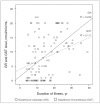3-Nitrotyrosine and glutathione antioxidant system in patients in the early and late stages of bipolar disorder
- PMID: 19568477
- PMCID: PMC2702443
3-Nitrotyrosine and glutathione antioxidant system in patients in the early and late stages of bipolar disorder
Abstract
Background: There has been an increasing interest in the role of oxidative stress in the pathophysiology of bipolar disorder. To explore this further, we evaluated the activity of glutathione peroxidase (GPx), glutathione reductase (GR) and glutathione S-transferase (GST), as well as 3-nitrotyrosine levels and carbonyl content in patients in the early (within 3 years of illness onset) and late (a minimum of 10 years of illness) stages of bipolar disorder.
Methods: We matched 30 patients in the early stage and 30 patients in the late stage of bipolar disorder, diagnosed according to DSM-IV criteria, with 60 healthy controls (30 matched for each group of patients). We measured symptomatic status using the Hamilton Rating Scale for Depression and the Young Mania Rating Scale.
Results: We found a significant increase in 3-nitrotyrosine levels among patients in the early (p < 0.010) and late (p < 0.010) stages of bipolar disorder. The activity of GR and GST was increased only among patients in the late stage of illness. Glutathione peroxidase activity and carbonyl content did not differ among the groups.
Limitations: Limitations of our study include its cross-sectional design, which did not allow us to examine direct causative mechanisms or the effects of progression of illness, and the potential environmental bias introduced by comparing patient groups recruited from different regions of the world.
Conclusion: Our data indicate a possible tyrosine nitration-induced damage in patients with bipolar disorder that is present from the early stage of illness. Our data also indicate that patients in the late stage of illness demonstrate enhanced activity of GR and GST, which could suggest the involvement of a compensatory system in bipolar disorder.
Figures



References
-
- Belmaker RH. Medical progress: bipolar disorder. N Engl J Med. 2004;351:476–86. - PubMed
-
- Sajatovic M. Bipolar disorder: disease burden. Am J Manag Care. 2005;11(Suppl):S80–4. - PubMed
-
- Kupfer DJ. The increasing medical burden in bipolar disorder. JAMA. 2005;293:2528–30. - PubMed
-
- McIntyre RS, Konarski JZ, Soczynska JK, et al. Medical comorbidity in bipolar disorder: implications for functional outcomes and health service utilization. Psychiatr Serv. 2006;57:1140–4. - PubMed
MeSH terms
Substances
LinkOut - more resources
Full Text Sources
Medical
Research Materials
